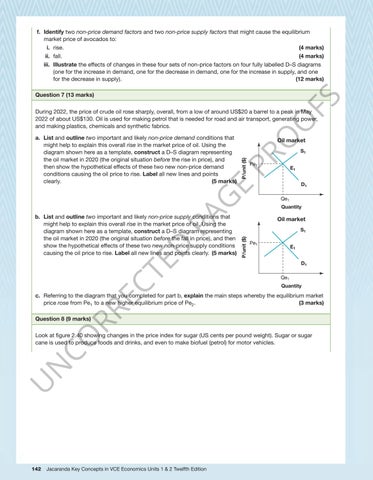“c02DecisionMakingInMarkets_PrintPDF” — 2022/5/25 — 13:13 — page 142 — #76
f. Identify two non-price demand factors and two non-price supply factors that might cause the equilibrium market price of avocados to: i. rise. (4 marks) ii. fall. (4 marks) iii. Illustrate the effects of changes in these four sets of non-price factors on four fully labelled D–S diagrams (one for the increase in demand, one for the decrease in demand, one for the increase in supply, and one for the decrease in supply). (12 marks)
FS
Question 7 (13 marks)
O
Oil market
Pe1
G
D1 Qe1 Quantity
Oil market S1 P/unit ($)
PA
CO RR EC
TE
D
b. List and outline two important and likely non-price supply conditions that might help to explain this overall rise in the market price of oil. Using the diagram shown here as a template, construct a D–S diagram representing the oil market in 2020 (the original situation before the fall in price), and then show the hypothetical effects of these two new non-price supply conditions causing the oil price to rise. Label all new lines and points clearly. (5 marks)
S1
E1
E
P/unit ($)
PR
a. List and outline two important and likely non-price demand conditions that might help to explain this overall rise in the market price of oil. Using the diagram shown here as a template, construct a D–S diagram representing the oil market in 2020 (the original situation before the rise in price), and then show the hypothetical effects of these two new non-price demand conditions causing the oil price to rise. Label all new lines and points clearly. (5 marks)
O
During 2022, the price of crude oil rose sharply, overall, from a low of around US$20 a barrel to a peak in May 2022 of about US$130. Oil is used for making petrol that is needed for road and air transport, generating power, and making plastics, chemicals and synthetic fabrics.
Pe1
E1 D1 Qe1 Quantity
c. Referring to the diagram that you completed for part b, explain the main steps whereby the equilibrium market price rose from Pe1 to a new higher equilibrium price of Pe2 . (3 marks) Question 8 (9 marks)
U
N
Look at figure 2.40 showing changes in the price index for sugar (US cents per pound weight). Sugar or sugar cane is used to produce foods and drinks, and even to make biofuel (petrol) for motor vehicles.
142
Jacaranda Key Concepts in VCE Economics Units 1 & 2 Twelfth Edition





















































